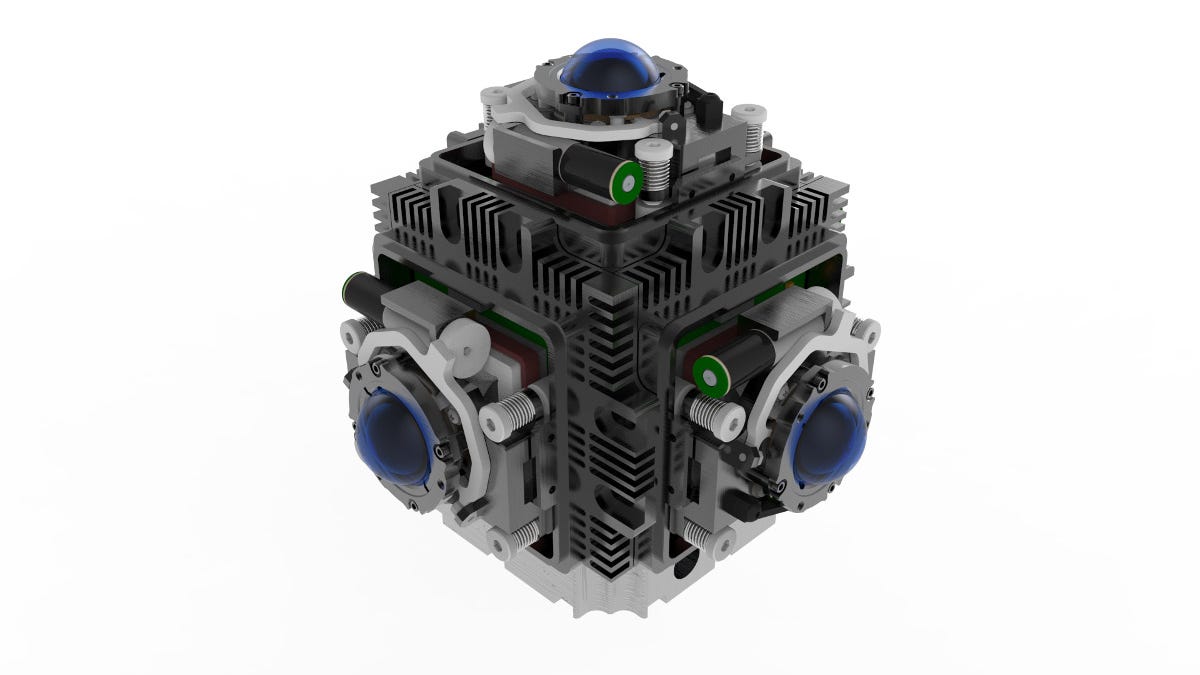This crazy camera could be a boon to VR filmmakers
Researchers have found a way to build a 360-degree camera that's compact but shoots high-quality video. It could be just the thing for virtual reality.
If you're trying to create immersive virtual-reality video today, you've got a problem: choosing between a camera that's compact or a bulkier one that offers sharp imagery.
Researchers at the University of California at San Diego, though, have found a way to get the best of both worlds. It's a camera called PMast.
The camera is just a prototype today, a cube bulging with lenses and laced with fiber-optic cables. But the design eventually could help bring immersive video to movies, sports and concerts. That's critical as virtual reality -- the technology to digitally transport you into an African safari or an Himalayan ascent -- starts to take off with high-profile backers like Facebook, Google and Samsung all investing in different headsets.
Hollywood's also dabbling in VR, looking for fresh tech spins on traditional storytelling. At the Sundance Film Festival this week, virtual reality's one of the attractions in movies like "Dear Angelica," which wants to get you inside a painter's brain.
But while there are a number of different setups, from the high-end $600 Oculus Rift from Facebook to Google's $50 Daydream headset, there's still insufficient VR content to tempt mainstream consumers. While a handful of companies are starting to build smaller, more convenient 360-degree cameras, PMast is as compact as a handful of cheap GoPro action cameras but can capture the rich, high-resolution imagery that professionals need, said Joseph Ford, a UCSD professor who helped lead the project.
The five-lens PMast, upper right, is about the size of a conventional SLR but can capture many more megapixels of wraparound video.
"Ultimately we'd love to work with a camera developer," Ford said. "When they've reached the point where the lens is a significant part of the weight and bulk and obtrusiveness of the camera, then our lens offers a solution."
Camera frontier
PMast's creators, the Photonic Systems Integration Laboratory and Distant Focus Corporation, aren't the only ones tackling the problems of 360-degree video.
Google's Jump technology is designed to make it easier for videographers to build their own VR camera designs. GoPro is a prominent Jump partner with its GoPro Odyssey camera rig, and Imax and Yi also have Jump designs. Other makers of wraparound camera include Jaunt and Nokia, whose high-end Ozo costs $60,000.
It's not clear yet whether 360-degree video will grow up from today's niche uses like virtual tourism. You can watch panoramic video on sites like Facebook and YouTube, but it can be tough telling where you should be looking when the action can be all around you. VR headsets offer a better way to watch wraparound video, since it's easy to turn your head to see what's going on, but few people own them and image quality so far isn't very high.
Given the visceral impact of the medium, though, plenty of technology companies and video creators are seeing what's possible.
Pricing for the PMast design is hard to pin down -- it was designed for the Defense Advanced Research Projects Agency (DARPA) and not as a commercial project. But it won't be cheap. Cinema-grade cameras typically cost tens of thousands of dollars.
Curvaceous
PMast, a cubic design about the size of a conventional SLR, combines unusual spherical lenses with even more unusual bundles of carefully engineered fiber-optic strands. Five faces have spherical lenses bubbling out and large 25-megapixel sensors within. The sixth face has a camera mounting stalk and a fiber-optic link that sends data to computers that stitch the images into a single wraparound video.
A core innovation in the PMast is a lens that looks more like a marble than the convex and concave disks you'll see in conventional camera lenses. The 16mm sphere is smaller in diameter than a dime and provides excellent optical performance.
"Spherical lenses are insanely good at focusing light," Ford said.
The diagram at left shows how light travels through the spherical (monocentric) lens then focuses on the inner surface of the fiber-optic bundle. The image at right shows the fiber-optic bundle itself, about an inch on edge.
Well, insanely good as long as you throw out a fundamental design principle of today's camera. Mainstream lenses are complicated in part because they have to focus an image on a flat image sensor. Spherical lenses are no good at focusing an image on a plane.
But the PMast team figured a way around the problem using fiber optics, superthin threads of glass that can transmit light along their length.
A bundle of high-end fiber-optic strands, bent inward the way your fingertips converge when you're trying to pick up a tiny screw you dropped on the floor, provides the concave spherical surface on which the lens focuses its image. Those fibers then carry the image to the flat surface of the sensor.
Five lens-sensor modules are mounted onto the PMast's cubic frame. Electronics there pull the data off the sensors, but most of the grunt work of image processing -- tasks like correcting color and contrast -- takes place on an accompanying cart with five beefy computers.
The cart's bulk contrasts with the compactness of the camera, but the good news is that the computers can be hidden away thanks to a long fiber-optic line. That's perfect if you're shooting a movie with some future version of PMast.
And someday, Ford hopes, he'll see that movie. "Nothing could be more satisfying than go to a Hollywood premiere," he said.
CNET Magazine: Check out a sampling of the stories you'll find in CNET's newsstand edition, right here.
Tech Enabled: CNET chronicles tech's role in providing new kinds of accessibility. Check it out here.


